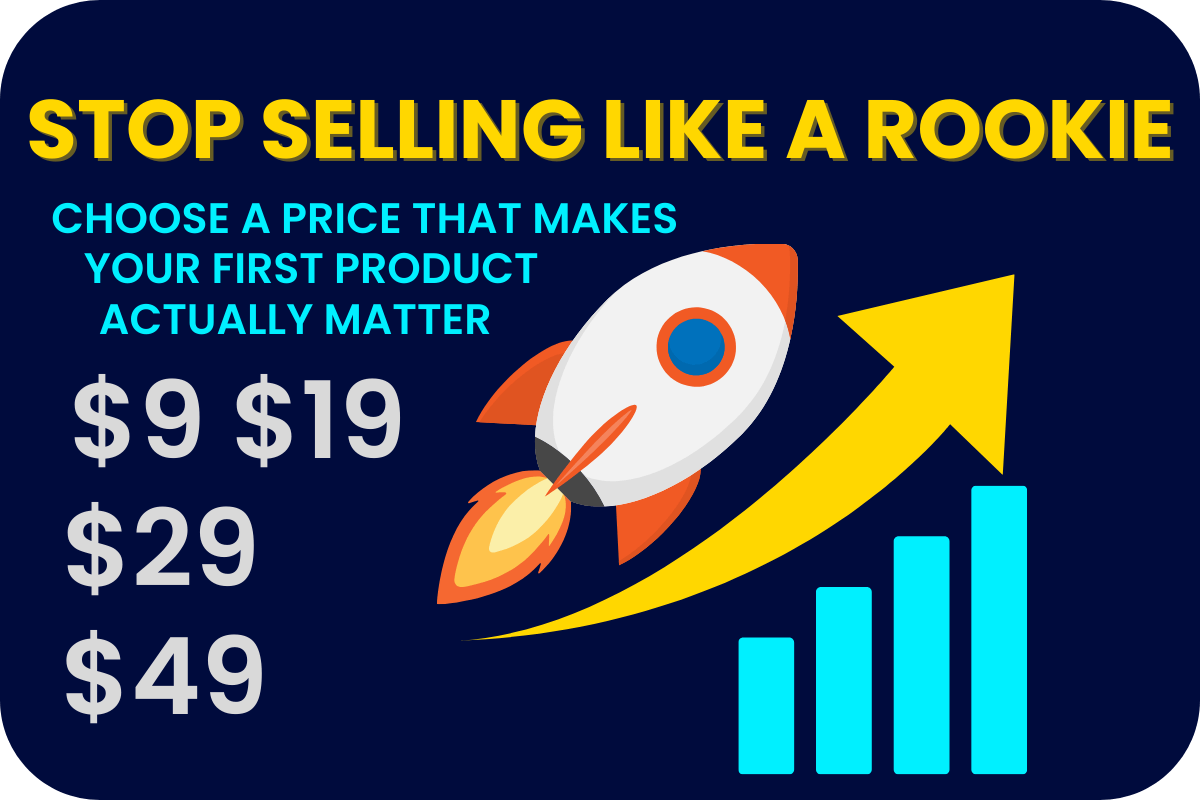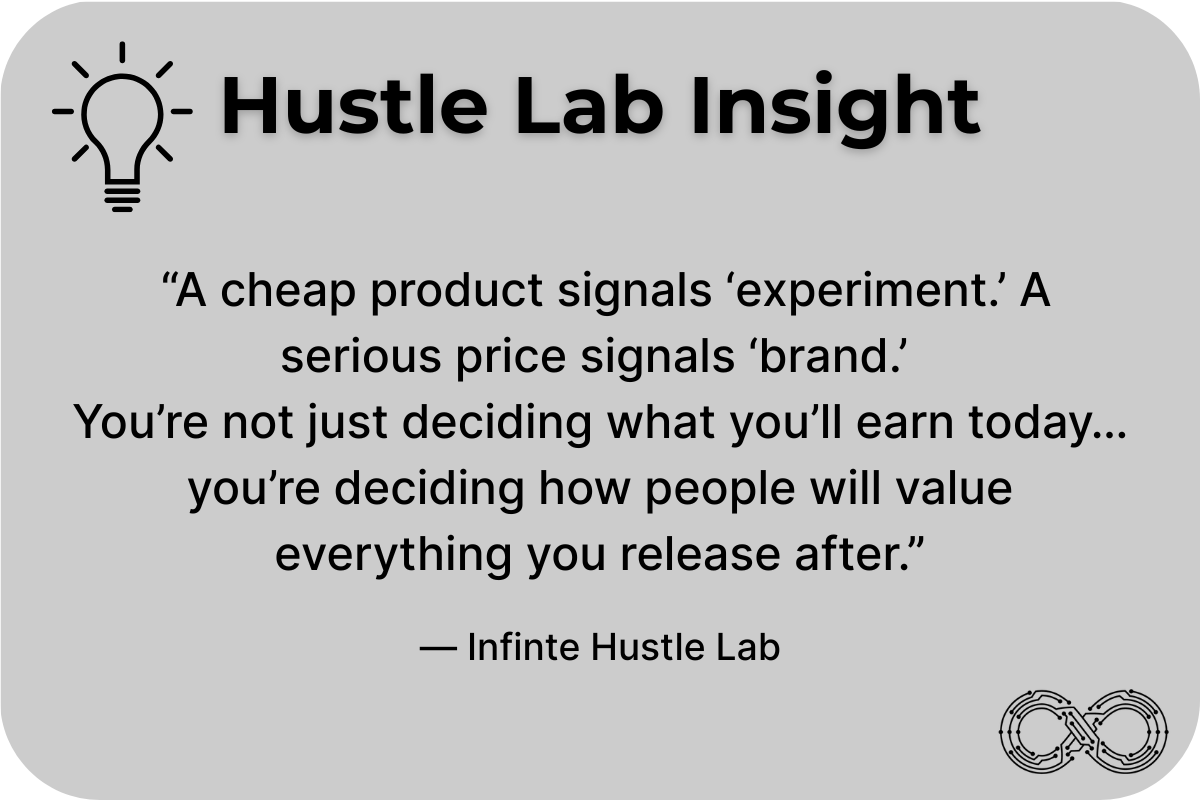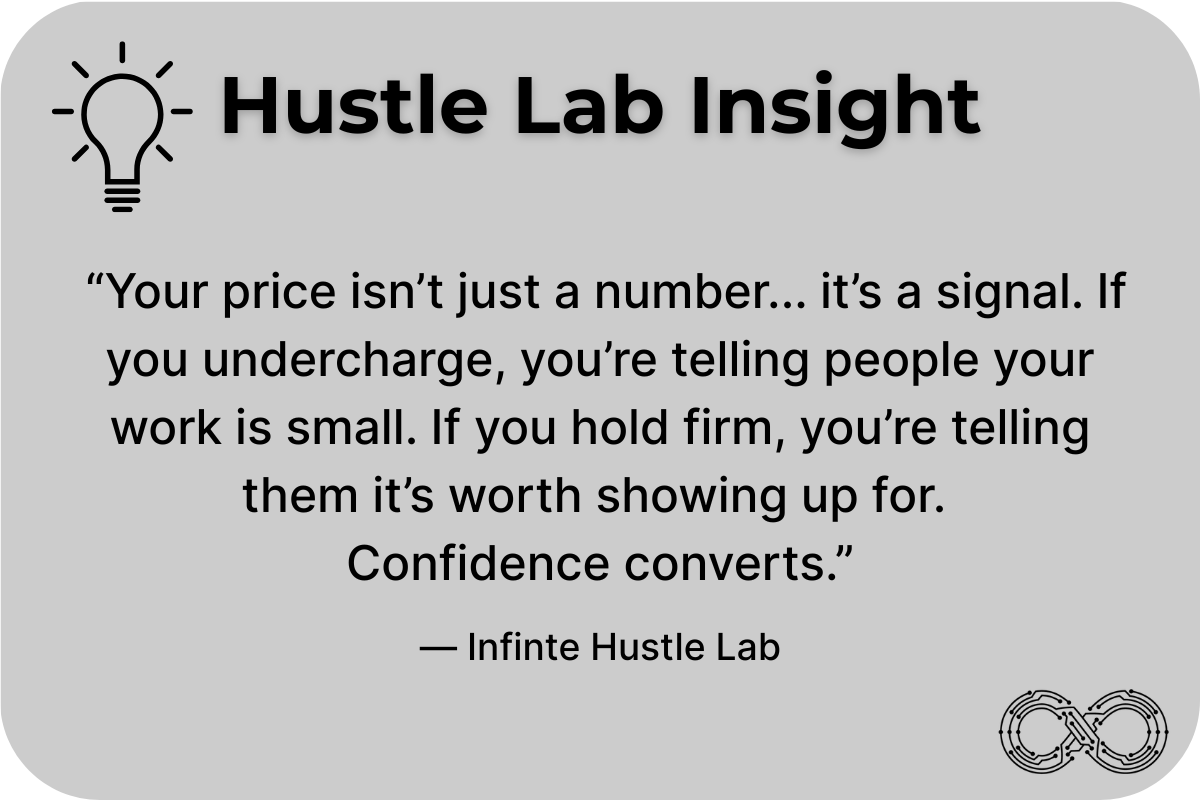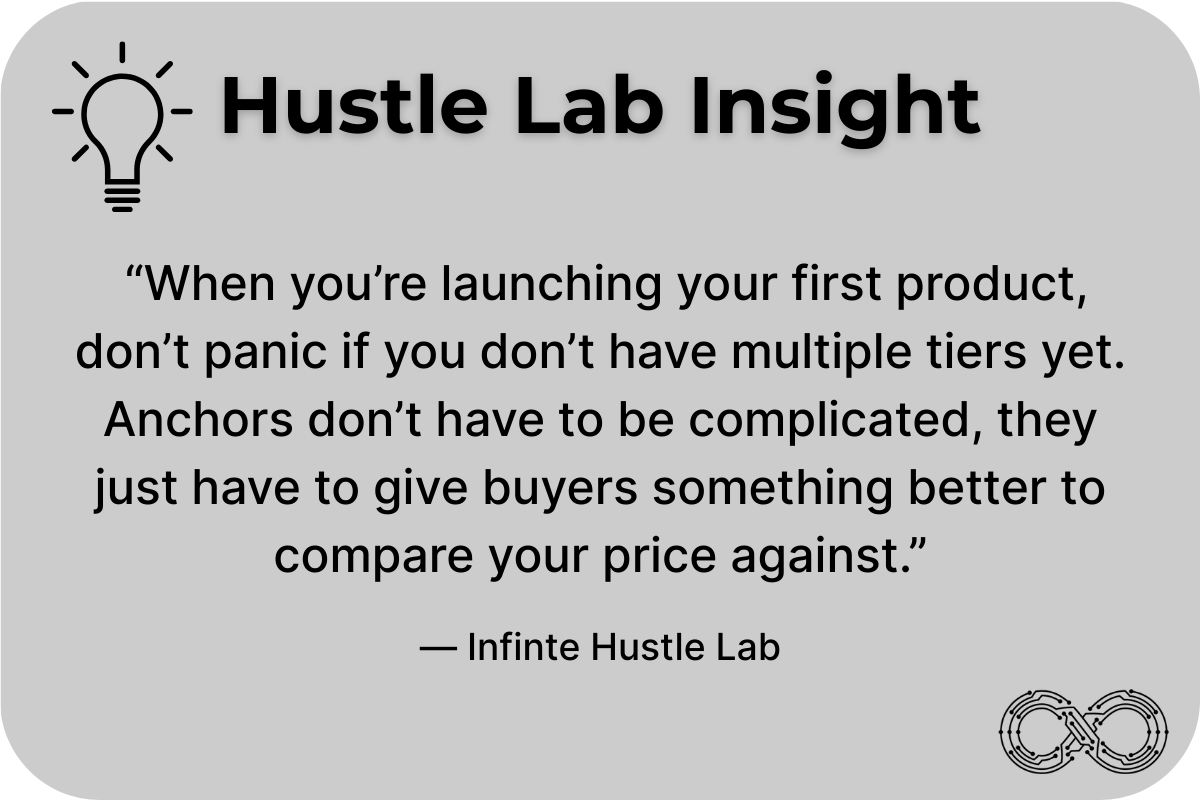
Build Real Income with AI-Powered Leverage

Build Real Income with AI-Powered Leverage
Your price isn’t just a number — it’s a filter. In this article, we break down simple strategies for pricing digital products that actually sell. Learn how to set numbers that attract serious buyers, test the market without overthinking, and adjust as you grow.

Most first-time creators obsess over the wrong thing.
They polish the product, tweak the design, add “just one more” bonus, and then sabotage themselves with the price tag.
I know, because I did it.
My first digital product went out at $9. It felt “safe," like I was lowering the risk for buyers.
What actually happened? People treated it like a throwaway. No urgency. No authority. Just another cheap download.
That’s when it hit me, your first digital product isn’t judged only by what’s inside.
It’s judged by the number you stick on it. That number tells your buyers if you’re someone to take seriously, or just another rookie testing the waters.
The truth is, a $9 product doesn’t change your life. It doesn’t build your brand. And it doesn’t make anyone believe you have the authority to guide them.
But the right price?
It can flip the entire perception of your product overnight. It can go from “cheap” to “worth my time” simply by swapping some digits and pricing it for what it is really worth.
Let’s break down exactly how pricing shapes trust, authority, and momentum when you’re just starting out.
When most people launch their first product, $9 feels like the “no-brainer” price.
It’s low enough that you assume people won’t hesitate.
It feels like you’re removing every possible barrier.
But here’s the truth: $9 isn’t safe… it’s forgettable.
Think about it, when was the last time you bought something for $9 online and actually remembered it a week later?
Exactly.
That’s the danger. At $9, your product gets tossed in the same mental bucket as an extra coffee, a cheap app, or a digital trinket that never really mattered.
Customers don’t just buy a product, they buy into what it says about them.
A $9 product tells them: this is a small, disposable thing. It’s not a tool they’ll commit to, it’s an impulse buy they’ll skim and never use.
And if they never use it, it never changes them, which means it never builds your reputation.
I learned this the hard way.
My first attempt was priced low because I thought affordability was the hook.
I made a handful of sales, but nothing stuck.
People downloaded it, maybe skimmed a page or two, and moved on. No one emailed me back. No one talked about it. And no one came back for the next thing.
That’s the hidden cost of underpricing, you think you’re being beginner-friendly, but you’re actually teaching people not to take you seriously.
If you want proof, look at the creators who actually break out.
None of them are making their mark with $9 throwaway products.
They’re charging enough that buyers feel the weight of the purchase, and it’s that weight that makes them engage.
If you start at $9, you’re playing defense.
You’re signaling that you’re still testing the waters, not building something that matters.
And nobody builds a brand that way.
If you want to see what a stronger launch strategy looks like, check out my post on how to sell your first digital product.

A $9 price tag feels safe. It lowers resistance, gives you a quick dopamine hit when someone buys, and makes you believe you’ve hacked the system.
But in reality, it locks you into a business model that can’t scale.
Here’s why:
1. The math doesn’t add up. Think about it: to make just $1,000, you’d need 112 buyers at $9. Compare that to $29 — only 34 buyers. Or $49 — just 21. Same work to create the product, completely different payoff.
2.Cheap attracts the wrong crowd. Lower prices bring in bargain hunters, the people most likely to refund, complain, or never even use what they bought. The buyers who pay $49 actually value the outcome and stick around longer.
3. It pushes you into a volume game. Selling cheap means you’re trapped chasing bigger and bigger numbers just to keep the lights on. That’s not a system you can scale solo… it’s a treadmill.
The price you pick isn’t just about what feels comfortable. It’s about whether you want to build a business that feeds you or a hamster wheel that burns you out.
If you want a breakdown of how to structure your first offer so it builds into something scalable, read The Simple System That Sold My First Product.
There’s no one “right” number, but most creators land between $19 and $49. Low enough that a beginner will take the leap, but high enough that the sale actually matters.
Usually, yes. At that price you need a huge audience to make it work, and it signals low value. A slightly higher price often sells better because it tells buyers you’re serious.
Watch behavior. If people show interest but don’t buy, or you get consistent “too expensive” feedback, test lowering slightly. But don’t assume — let data, not fear, guide you.

The Backdoor Blueprint is the 12-page starter guide to the Infinite Hustle Lab system. It's the exact strategy we use to build lean, scalable digital income streams.
Trusted by 500+ solopreneurs building real systems around the world.

The AI Income Stack gives you five proven ways to turn tools into income — including self-publishing, affiliate funnels, and automation-based product sales.
Perfect for anyone starting from scratch who wants to build smarter.

This is the master strategy guide for monetizing automation — without gimmicks or hype. If you want to build real income using smart tools and scalable systems, this is where to start.
When you price your first product in the $19–$49 range, you step into a completely different game.
This isn’t just about picking a number, it’s about building leverage without breaking trust.
• It builds momentum fast. Ten buyers at $29 puts nearly $300 in your pocket. That’s not life-changing money, but it’s the kind of traction that flips the switch from “I’m trying” to “I’m building.”
• It attracts action-takers, not dabblers. Free or $5 products bring in curious clickers who never open what they bought. At $29, people lean in. They read, apply, and finish. That energy builds social proof and case studies you can reuse later.
• It positions you as credible. $29 signals a real business, not a hobby. A product in this range says: this is valuable enough to charge for, but accessible enough for beginners to take a chance on.
The danger at this stage isn’t overpricing… it’s underpricing. Start too low and you trap yourself:
• You’ll need a huge volume to see results.
• You’ll attract more “tourists” than committed buyers.
Raising prices later feels like a betrayal instead of a natural progression.
Here’s a simple framework:
• Anchor your price at $29 or $49.
• Push traffic through and watch conversions.
• If sales trickle but don’t close, drop to $19 only as a test.
Never launch at $9. Climbing up from “cheap” is 10x harder than adjusting down from “serious".
This range isn’t about getting rich off your first 50 customers, it’s about stacking proof. Every sale validates your system, every customer becomes part of your audience, and every dollar can be reinvested.
Want inspiration on what products actually fit this range? Check out Smart Digital Products to Sell in 2025.
Most creators sabotage themselves not with the wrong price, but with the wrong energy.
They hedge. They discount too soon. They sprinkle in “sorry it costs money” undertones in their copy. And the buyer picks up on it instantly.
When you sell, you’re not just offering a product, you’re projecting belief.
Price is a signal.
A $49 product tells the market “this is structured, actionable, and worth paying for."
A $7 toolkit with the same content tells the market “I’m not sure this is valuable, but maybe you’ll take a chance.”
Buyers don’t just buy the product; they buy the conviction behind it.
The “discount trap” is where most beginners fall.
They price at $29, get nervous when sales don’t fly in on day one, and slash to $9 hoping volume will fix it.
It never does.
Volume doesn’t come without demand, and demand doesn’t grow when you signal desperation.
Instead, you train your audience to expect low effort, low value, and low trust.
Once your brand is anchored cheap, climbing back up is nearly impossible. You’ve already positioned yourself as a bargain-bin creator, even if your work is strong.
Serious buyers don’t trust “too cheap.”
If you’re promising transformation but pricing like a cup of coffee, it sends mixed signals.
People who want real results expect to pay a real price.
A $39 starter product feels like a commitment, not an impulse buy.
That tiny leap filters in the exact kind of audience you want: motivated, serious, and willing to follow through. The bargain hunters? They bounce. And that’s a good thing.
Think of price as part of the system.
Just like funnels over followers build leverage through structure, holding firm on your price builds leverage through belief.
The creator who doesn’t apologize for charging communicates one thing clearly, this product is worth it, and so are you.
It’s not about gouging. It's about aligning what you built with the value it delivers and refusing to flinch when someone says “too expensive.”
If ten people buy at $39 with conviction, that’s stronger than fifty people who only clicked at $9 out of curiosity. The former creates retention, testimonials, and long-term trust. The latter creates refunds, disengagement, and noise.
Pricing isn’t just math. It’s marketing. And confidence in your number is half the sale.

Price never lives in isolation, people judge it against something else.
That “something else” is the anchor. If you don’t set the anchor, the market will do it for you.
Most beginners assume the anchor is the competition’s price. It doesn’t have to be.
Anchors can be created deliberately:
• Tiered Offers: A $49 product looks affordable next to a $199 package, even if you only want to sell the $49.
• Value Framing: Showing what the result is worth (“This can replace spending $200 a month on X”) makes your price look small by comparison.
• Time Trade: Positioning your offer against the hours it saves reframes cost into leverage (“Would you spend $49 to save 20 hours of trial and error?”).
• Lifestyle Comparison: People regularly drop $5 a day on coffee without thinking twice. Framing your product against that familiar habit (“This costs less than one coffee a week”) makes the decision feel trivial.
Here’s how it plays out in practice:
Imagine you release two versions of the same system:
• A basic version at $49
• A premium bundle at $199
Even if you don’t expect many people to buy the $199 option, its presence shifts perception.
Suddenly, $49 no longer feels like a “risk”. It feels like a smart, low-bar entry point. Without that higher anchor, $49 stands alone, and buyers may hesitate.
Here’s another angle, compared against non-financial anchors.
Say your system replaces weeks of trial and error.
The moment you say, “Most people spend 40 hours figuring this out on their own,I’ll save you that for $49,” you’ve changed the calculation.
Now, they’re no longer weighing $49 against their wallet; they’re weighing it against their time, stress, and momentum.
The wrong anchor cheapens you. Leading with discounts, comparing yourself to bargain options, or positioning your product as “just a PDF” all drag the perceived value down.
The right anchor makes your number feel natural, even obvious.
This is why luxury brands never apologize for a $500 bag. They set the anchor by pointing at craftsmanship, lifestyle, and the alternative costs.
For creators, anchoring is less about theatrics and more about clarity.
If you define the comparison, you guide the buyer’s judgment. If you don’t, they’ll invent their own and that usually won’t work in your favor.
Related: How to Build a Low-Ticket Digital Product Funnel That Actually Converts

One of the fastest ways to kill your sale is letting buyers believe your product is “just a PDF.”
That phrase isn’t about the format, it’s about perceived value. If all they see is a file, they’ll judge it as a cheap download.
If they see a system, a shortcut, or a result, the format disappears.
Here’s how to avoid the trap:
• Sell the Transformation, Not the File
People don’t want 42 pages of text. They want the outcome those 42 pages deliver. Lead with the system, the win, or the shortcut your PDF unlocks.
For example: “The 3-step product launch system that took me from zero to my first $500 sale” is infinitely stronger than “a 42-page eBook.”
• Make Delivery Part of the Experience
A PDF can feel thin. But bundle it with worksheets, checklists, or a Notion board, and suddenly it feels like a toolkit. The content might still live in a PDF, but the delivery feels layered, giving buyers something they can interact with.
• Reframe with Comparisons
Tie your product to what it replaces. A $29 guide isn’t “just a PDF” if it saves someone from paying $200 for a course or $500 for coaching. Anchoring your value to alternatives keeps buyers focused on the payoff, not the medium.
Here’s a quick example:
Imagine two creators selling essentially the same knowledge. Creator A says, “Get my 30-page PDF on product validation.”
Creator B says, “Steal my product validation system, the same one I used to launch a $2K/month side hustle. Includes step-by-step PDF guide + validation checklist.”
Who wins? Same format. Different framing.
Here’s another one:
Let’s say you’re teaching Instagram growth.
Creator A posts, “Download my 25-page Instagram guide (PDF).”
Creator B posts, “Use the exact content calendar I used to grow to 10k followers — full PDF breakdown + ready-to-use posting template.”
Both are PDFs. But one is “just information,” while the other is a shortcut into a proven system people already want.
The best part is, this isn’t about hype. It’s about aligning your product with the way buyers naturally evaluate value. If you control the frame, you control the perception.
Want more on turning simple products into systems that actually sell? Check out our article on how to sell your first digital product.
Want a deeper breakdown of how to structure offers so they sell (beyond just price)? Check out our article on the digital product framework that sells.
Pricing isn’t just math. It’s psychology.
The numbers you choose don’t just tell buyers what something costs, they signal how valuable it is, whether it feels like a deal, and whether the purchase feels safe or risky.
Think about the power of charm pricing.
There’s a reason you see $49.99 instead of $50.
It isn’t just a habit. Studies show buyers process the number from left to right, so “49” feels smaller than “50,” even if the difference is a penny. That small shift can mean a higher conversion rate without changing your product at all.
Anchoring works the same way. If you put a $199 offer next to your $49 product, the $49 suddenly looks like a bargain. The higher anchor frames the lower price as “safe,” even though the product hasn’t changed.
And then there’s the power of round numbers. In some cases, especially with premium products, clean numbers like $100 or $500 signal confidence and quality. The buyer isn’t hunting for cents, they’re buying the status of the product.
The key takeaway, the right number makes your product feel worth buying before the customer even reads the details. Price isn’t just cost. it’s positioning.
At the end of the day, pricing isn’t about guessing, it’s about matching your product’s promise with the buyer’s mindset.
• Low-ticket ($5–$19): Perfect for proving demand fast and turning curious browsers into paying customers.
• Mid-tier ($29–$99): Best balance of profit and accessibility — a sweet spot for many first-time creators.
• Premium ($100+): Works when you have clear authority and your product delivers a big transformation.
The real mistake isn’t choosing the “wrong” price, it’s staying stuck in research mode and never launching at all.
Set a number, put it in front of buyers, and let the market tell you what works.
Your price is just one piece of the equation. Inside the AI Money Machine Toolkit, you’ll see how to connect pricing, positioning, and funnels into a strategy that actually scales.
→ Check out the Toolkit here

The Backdoor Blueprint is the 12-page starter guide to the Infinite Hustle Lab system. It's the exact strategy we use to build lean, scalable digital income streams.
Trusted by 500+ solopreneurs building real systems around the world.

The AI Income Stack gives you five proven ways to turn tools into income — including self-publishing, affiliate funnels, and automation-based product sales.
Perfect for anyone starting from scratch who wants to build smarter.

This is the master strategy guide for monetizing automation — without gimmicks or hype. If you want to build real income using smart tools and scalable systems, this is where to start.




Leave a Comment